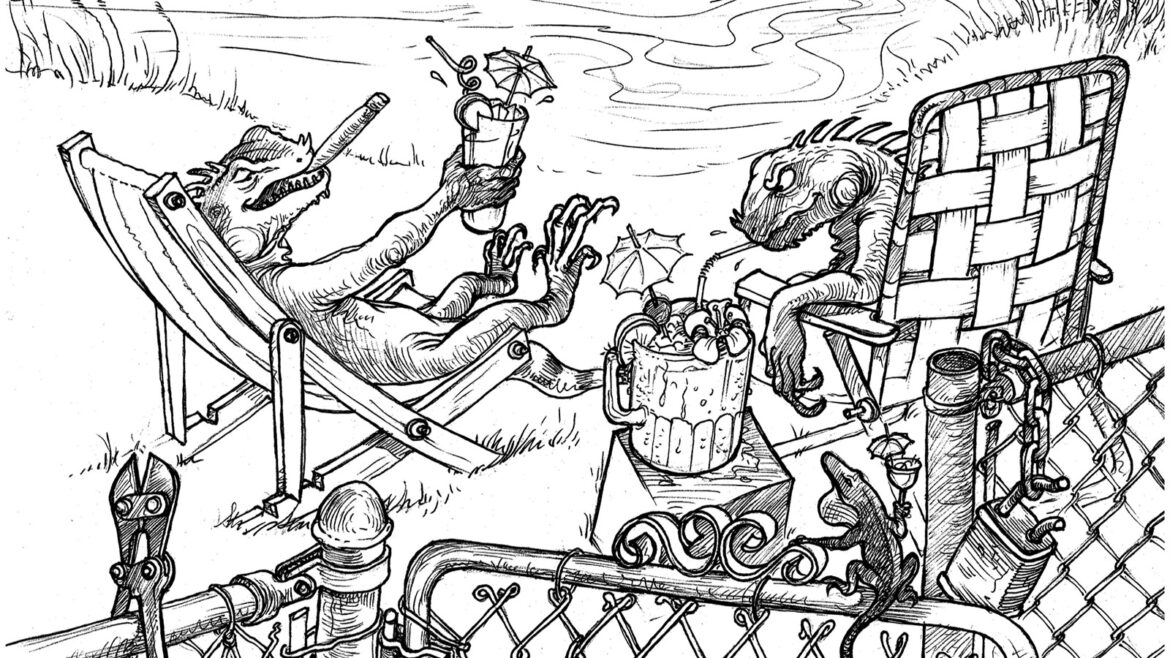Driving around South Florida this week made me think about how much city there is and how little food is being produced.
South Florida is basically a rainforest climate. The weather does not get too hot or too cold. There is usually enough rainfall to keep everything green. Yet much of South Florida is buildings and streets and parking lots and concrete and high-rises and more concrete. Whatever natural jungle used to be, there is mostly gone or in isolated pockets. Every invasive species in the world thrives in South Florida. There is very little native ecosystem left to preserve. Because so many species do well in South Florida’s mild, tropical climate, useful food plants are easy to grow. Grass does not do particularly well there, but forests do. Species grown as house plants in cooler climates grow to gigantic size in South Florida. If you set your potted ivy free, it will create huge lianas and climb a live oak or palm or the side of whatever convenient building happens to be available.
This is a great place to grow tropical forests, rather than typical vegetable gardens. Those struggle.
Since the area wants to be covered in forest, why not cover it in edible forest?
We did this in my parents’ small backyard in what I call the great south Florida food forest project. Mango, chocolate pudding fruit, starfruit, mulberry, bananas, plantains, curry tree, cassava, yams, sweet potatoes and a lot more thrive in this tiny backyard.
Unfortunately, the mindset in South Florida tends to be one of aesthetics instead of food production. Vast fortunes are made by landscaping companies, trying to take care of Saint Augustine grass and silver palms and crotons instead, when food forests could be feeding the entire city or at the very least providing them with fresh fruit year-round. There is a little space for livestock in South Florida. Chickens could easily fit in backyards and cows and goats could graze in the many open lots and sides available rather like we saw in the Caribbean. Instead, people keep expensive pets and expensive cars and expensive boats and expensive barbecue grills. This means almost all of the food in Fort Lauderdale in particular is coming from elsewhere. The city is a parasitic tick on the back of a large agricultural animal that stretches around the world.
With its unique climate, however, Fort Lauderdale could be producing a huge amount of food with the amount of fertilizing and landscaping and irrigation that is used to keep up appearances. If it were applied to food production, it would be astounding. This is a climate where you can grow coconuts. This is unique inside of the continental United States. Houses in South Florida cost a half $1 million or more. Why not grow some expensive fruit in the yard too? Something to think about.
Come join the new Survival Gardener community for answers to all your gardening questions –


10 comments
From what I hear, folks down there would not need to raise meat animals, since there are plenty of iguanas in the trees. :-)
Good point!
Absolutely! Palm Beach county used to have more cattle in the area than any concentrated area in the country. Late 18 hundreds and early 1900s… Because they could survive and thrive year round.
15 or so years ago I was working a gig in the area and stayed at a little inn in Miami lakes. Getting in late in the dark I hit the sack… A few hours later I awoke to the lowing of a cow. There was about 3-4 acres and a half dozen cows right next door. In a green pasture in Feb…
I spent a couple years in Orlando as a sprout .. I could always find places where food was growing, but I didn’t start having dreams about gardening there until years later .. funny thing, too, because I’m sure I hadn’t been planting veggies along the sidewalk .. but someone was Do you ever have dreams where you are walking through a garden, and you realize .. it isn’t YOURS? Regular rains during the summer .. what a blessing!
Spot on!
Really wish I’d moved to Florida in my youth. What fun it would be to grow year round. I scored a Sea Grape from the local Lowe’s on clearance because I couldn’t leave it there. Totally the wrong climate for it, too. Still going to figure out a way. It’s a beautiful plant. I may keep it in a large pot and bring it in during freezes.
Sad Truth. On my block not but 20 miles north of David’s old stomping grounds, only 1 in 10 houses have a single fruit tree, let alone several. The irony of it all, the few people I know that grow several fruit trees (no food forest per se) are all transplants from different countries and cultures. They get it! Even if not to fully feed yourself, but to have fresh goodness out of your yard that will blow away any store bought version. Wasted opportunity.
Yes, definitely. It was mostly the islanders growing food.
Yams, sweet potatoes, bananas, cassava, and black eyed peas grow like weeds in my St Pete backyard. with very little tending. Everglades tomato plants do too, but they don’t make as much fruit as I’d like.
You remind me that it’s time to plant some more black-eyed peas. You’re right!
Comments are closed.